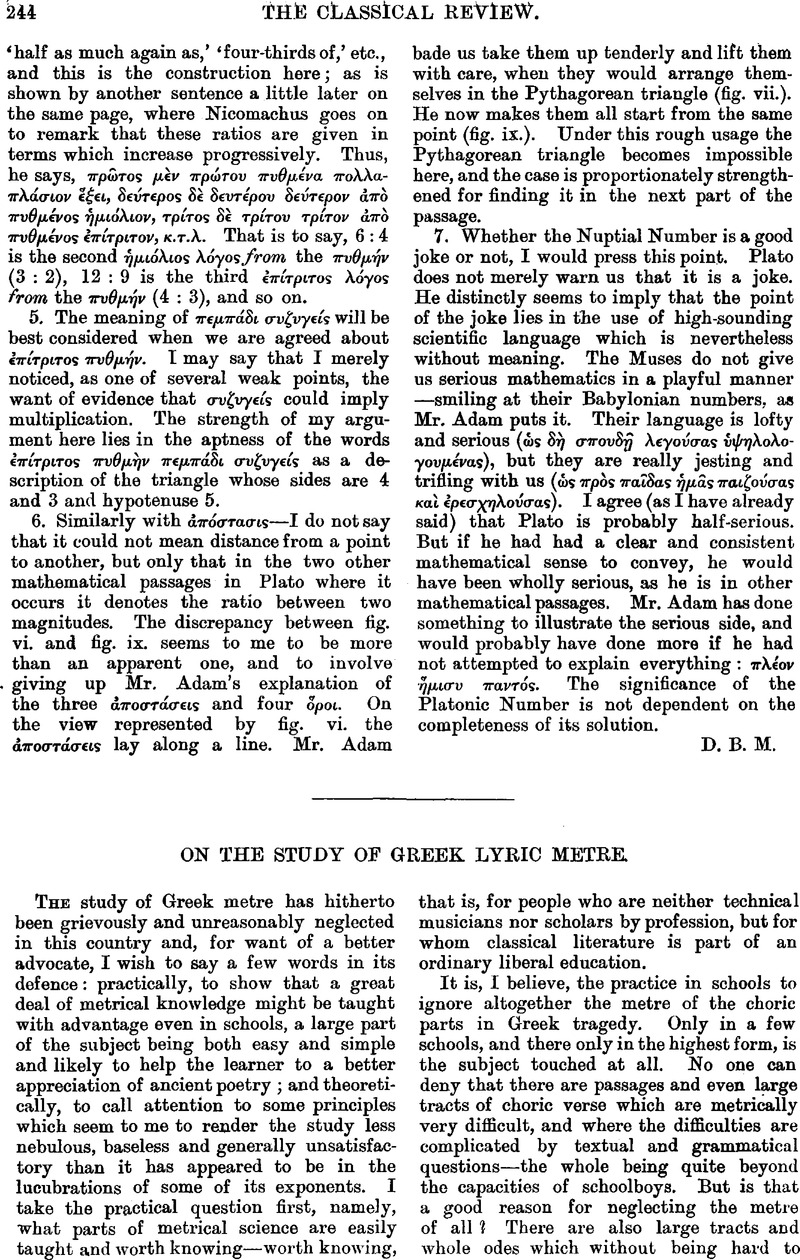No CrossRef data available.
Published online by Cambridge University Press: 27 October 2009

1 Schmidt's analyses of Sophoclean odes are full of illusions in regard to ⋯πισ⋯νθετα and μικτ⋯. Thus O. T. 1086 f. ![]() . is construed as ‘logaoedic’ The argument seems to be this: probably a ⋯π⋯ρχημα that is, a more lively Jyric than the usual στ⋯σιμα: therefore in
. is construed as ‘logaoedic’ The argument seems to be this: probably a ⋯π⋯ρχημα that is, a more lively Jyric than the usual στ⋯σιμα: therefore in ![]() time: therefore μικτ⋯ν in composition. Conversely, O.C. 1044,
time: therefore μικτ⋯ν in composition. Conversely, O.C. 1044, ![]() . is construed as ‘dactylic,’ in
. is construed as ‘dactylic,’ in ![]() time, when it is as plainly logaoedic as any ode ever was. There is not even the justification of appropriateness in
time, when it is as plainly logaoedic as any ode ever was. There is not even the justification of appropriateness in ![]() , for the song expresses lively excitement and curiosity. Some lines, it is true, in the middle of the strophe, approximate in form to ⋯πισ⋯νθετα, but at most this would lead us to classify the whole as partly logaoedic, partly ⋯πισ⋯νθετον. A change of time being assumed to be unlikely in a strophe, Schmidt's belief that ⋯πισ⋯νθετα must be in
, for the song expresses lively excitement and curiosity. Some lines, it is true, in the middle of the strophe, approximate in form to ⋯πισ⋯νθετα, but at most this would lead us to classify the whole as partly logaoedic, partly ⋯πισ⋯νθετον. A change of time being assumed to be unlikely in a strophe, Schmidt's belief that ⋯πισ⋯νθετα must be in ![]() time prevents him from recognizing any such fusion of forms or hybrid strophae. (See Prof. Jebb's ‘Metrical Analyses,’ Intr. to O.T. p. lxxxv., O.C. Ixxii.)
time prevents him from recognizing any such fusion of forms or hybrid strophae. (See Prof. Jebb's ‘Metrical Analyses,’ Intr. to O.T. p. lxxxv., O.C. Ixxii.)
Track. 496 f. μ⋯γα τι σθ⋯νος⋯ κ⋯πρις is taken by Schmidt to be logaoedic (v. Prof. Jebb's Introduction, p. lix.), but it is quite clearly ⋯πισ⋯νθετον. It runs thus:—

![]() does, it is true, look like logaoedic verse. But the illusion does not last when one remembers that in Pindar the last foot of the dactylic
does, it is true, look like logaoedic verse. But the illusion does not last when one remembers that in Pindar the last foot of the dactylic ![]() in
in ![]() is quite frequently a trochee. These lines run Δ(4) ε ε Δ(4) ε Δ ε Δ. &c.
is quite frequently a trochee. These lines run Δ(4) ε ε Δ(4) ε Δ ε Δ. &c.
1 For the ![]() of the measure, it is in its general effect a trochaic dipody unhinged or thrown out of balance by a strong stress on one half of it: there-fore adapted to express mental disturbance: and hence constantly associated with the ecstatic worship of Cybele and Dionysus—being, for example, the metre of most of the lyrics in the Bacchae.
of the measure, it is in its general effect a trochaic dipody unhinged or thrown out of balance by a strong stress on one half of it: there-fore adapted to express mental disturbance: and hence constantly associated with the ecstatic worship of Cybele and Dionysus—being, for example, the metre of most of the lyrics in the Bacchae.